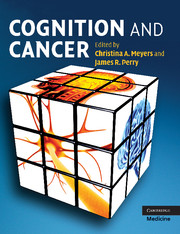Book contents
- Frontmatter
- Contents
- List of contributors
- Preface
- Section 1 Cognition and the brain: measurement, tools, and interpretation
- Section 2 Effects of cancer and cancer treatment on cognition
- 7 Biological bases of radiation injury to the brain
- 8 Cognitive dysfunction related to chemotherapy and biological response modifiers
- 9 Effect of hormones and hormonal treatment on cognition
- 10 Low-grade gliomas
- 11 High-grade gliomas
- 12 Brain metastases
- 13 Primary central nervous system lymphoma
- 14 Childhood brain tumors
- 15 Neurofibromatosis
- 16 Hematological malignancies
- 17 Paraneoplastic disorders
- 18 Symptomatic therapies and supportive care issues
- 19 Animal models and cancer-related symptoms
- Section 3 Interventions and implications for clinical trials
- Index
- Plate section
- References
17 - Paraneoplastic disorders
Published online by Cambridge University Press: 13 August 2009
- Frontmatter
- Contents
- List of contributors
- Preface
- Section 1 Cognition and the brain: measurement, tools, and interpretation
- Section 2 Effects of cancer and cancer treatment on cognition
- 7 Biological bases of radiation injury to the brain
- 8 Cognitive dysfunction related to chemotherapy and biological response modifiers
- 9 Effect of hormones and hormonal treatment on cognition
- 10 Low-grade gliomas
- 11 High-grade gliomas
- 12 Brain metastases
- 13 Primary central nervous system lymphoma
- 14 Childhood brain tumors
- 15 Neurofibromatosis
- 16 Hematological malignancies
- 17 Paraneoplastic disorders
- 18 Symptomatic therapies and supportive care issues
- 19 Animal models and cancer-related symptoms
- Section 3 Interventions and implications for clinical trials
- Index
- Plate section
- References
Summary
Introduction
Neurological paraneoplastic disorders refer to non-metastatic disorders that are not attributable to the toxicity of cancer therapy, cerebrovascular disease, coagulopathy, infection, or toxic and metabolic causes. Paraneoplastic disorders can affect any part(s) of the central (CNS) or peripheral (PNS) nervous systems (Table 17.1). Patients can be roughly grouped into those with pure or relatively pure clinical involvement of one part of the nervous system, such as cerebellar degeneration or sensory neuronopathy, and those with signs and symptoms of a diffuse and multifocal “paraneoplastic encephalomyelitis” (Dropcho, 2002; Graus et al., 2004). Several syndromes should always raise the possibility of a paraneoplastic etiology, including Lambert–Eaton myasthenic syndrome, subacute cerebellar degeneration, severe sensory neuronopathy, limbic encephalopathy, and opsoclonus-myoclonus. None of the clinical syndromes, however, have an absolute association with neoplasia, and each can occur in patients without tumors.
For any paraneoplastic neurological disorder, there is a clear over-representation of one or a few particular neoplasms. Overall, small cell lung carcinoma is the tumor most often associated with paraneoplastic phenomena in adults, although the actual incidence of paraneoplastic disorders among patients with this tumor is probably no more than 1%–3%. Other tumors over-represented among adults with paraneoplastic syndromes include breast carcinoma, ovarian carcinoma, Hodgkin's lymphoma, thymoma, and testicular germ cell tumors. Except for opsoclonus-myoclonus associated with neuroblastoma, paraneoplastic disorders in children are rare.
- Type
- Chapter
- Information
- Cognition and Cancer , pp. 239 - 257Publisher: Cambridge University PressPrint publication year: 2008



